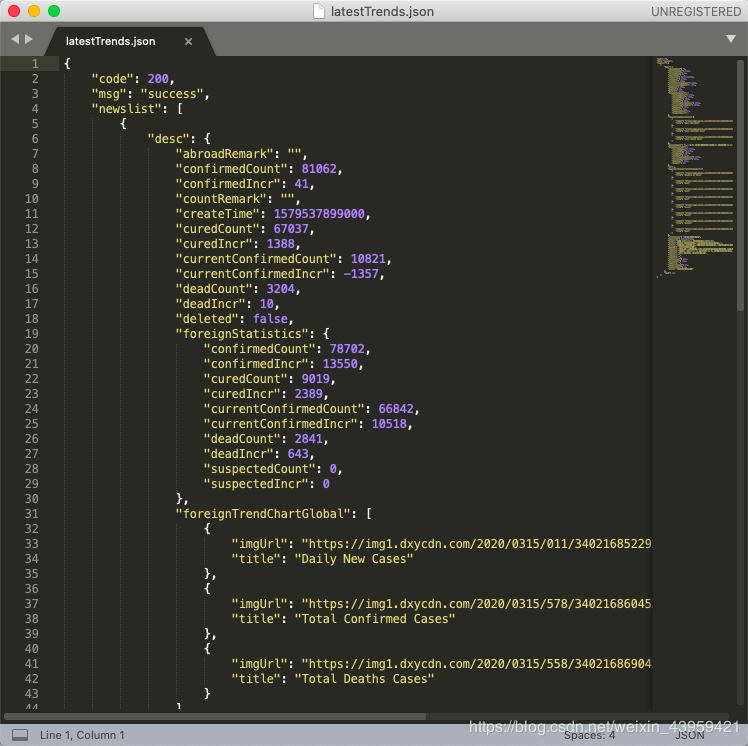利用python繪制數據曲線圖的實現
”在舉國上下萬眾一心、眾志成城做好新冠肺炎疫情防控工作的特殊時刻,我們不能親臨主戰場,但我們能堅持在大戰中堅定信心、不負韶華。“
1、爬取新聞保存為json文件,并將繪圖所需數據保存至數據庫
數據庫表結構:

代碼部分:
import pymysqlimport reimport sys,urllib,jsonfrom urllib import requestfrom datetime import datetimeimport pandas as pdToday=datetime.now().strftime(r'%Y-%m-%d')#Today=’2020-02-14’def pachong(): url=’http://api.tianapi.com/txapi/ncov/index?key=xxx&date={}’.format(Today) req = request.Request(url) resp = request.urlopen(req) content = resp.read().decode() data=json.loads(content) with open(’/Users/zhangyuchen/Desktop/latestTrends.json’,’w’) as fp:#將所得的數據存儲為json文件 json.dump(data,fp = fp,ensure_ascii = False,indent = 4,sort_keys=True) #dump函數有很多參數,第一個是目標object,第二個是要寫入的文件對象 print('成功保存為json文件!') return(re.findall(r’'confirmedCount':(.+?),'’,content),re.findall(r’'currentConfirmedCount':(.+?),'’,content),re.findall(r’'curedCount':(.+?),'’,content))def connectMysql(cc): #/usr/local/mysql/bin/mysql -u root -p db = pymysql.connect('localhost', 'root', '密碼', 'dbname',charset=’utf8’ ) cursor = db.cursor() sql='''insert into {0} (DATE,SICK,SICK_NOW,RECOVER)values(’{1}’,’{2}’,’{3}’,’{4}’)''' cursor.execute(sql.format(’db1’,Today,int(cc[0][0]),int(cc[1][0]),int(cc[2][0]))) cursor.execute(sql.format(’db2’,Today,int(cc[0][1]),int(cc[1][1]),int(cc[2][1]))) db.commit() print(('成功將{}數據存入數據庫!').format(Today)) db.close()cc=pachong()connectMysql(cc)
json文件:

2、利用matplotlib庫函數繪制圖表
import numpy as npimport matplotlib.pyplot as pltimport matplotlibimport pymysqlimport reimport sys, urllib,jsonfrom urllib import request#/usr/local/mysql/bin/mysql -u root -pdate=[]cSick=[]aSick=[]cNowSick=[]aNowSick=[]cRecover=[]aRecover=[]db = pymysql.connect('localhost', 'root', '密碼', 'trends')sql='select * from db1 ORDER BY DATE'cursor = db.cursor()cursor.execute(sql)results = cursor.fetchall()while results: for row in results: date.append(row[0].strftime('%d')) cSick.append(row[1]) cNowSick.append(row[2]) cRecover.append(row[3]) results=cursor.fetchone()#查詢Abroad Tablesql='select * from db2'cursor.execute(sql)results = cursor.fetchall()while results: for row in results: aSick.append(row[1]) aNowSick.append(row[2]) aRecover.append(row[3]) results=cursor.fetchone()cursor.close()db.close()def DrawLineChart(ySick,yNowSick): plt.plot(x,ySick,color=’y’,label='Cumulative number of cases',linewidth=3,linestyle='--') plt.plot(x,yNowSick,color=’r’,label='Current number of cases',linewidth=3,linestyle='-')def DrawBarChart(yRecover): width=0.45#柱子寬度 p2 = plt.bar(x,yRecover,width,label='Cured Count',color='#87CEFA')Days=len(aSick)plt.figure(figsize=(16,12), dpi=80)#設置分辨率為80像素/每英寸x=np.arange(Days)#創建兩個子圖plt.subplot(322)plt.title('Trends of March')DrawLineChart(cSick,cNowSick)DrawBarChart(cRecover)plt.figlegend()plt.xticks(x,date)plt.ylabel(’Number’)plt.subplot(324)#plt.title('Trends of March')DrawLineChart(aSick,aNowSick)DrawBarChart(aRecover)plt.xticks(x,date,rotation=0)plt.xlabel(’Date’)plt.ylabel(’Number’)plt.show()
到此這篇關于利用python繪制數據曲線圖的實現的文章就介紹到這了,更多相關python 數據曲線圖內容請搜索好吧啦網以前的文章或繼續瀏覽下面的相關文章希望大家以后多多支持好吧啦網!
相關文章:

 網公網安備
網公網安備